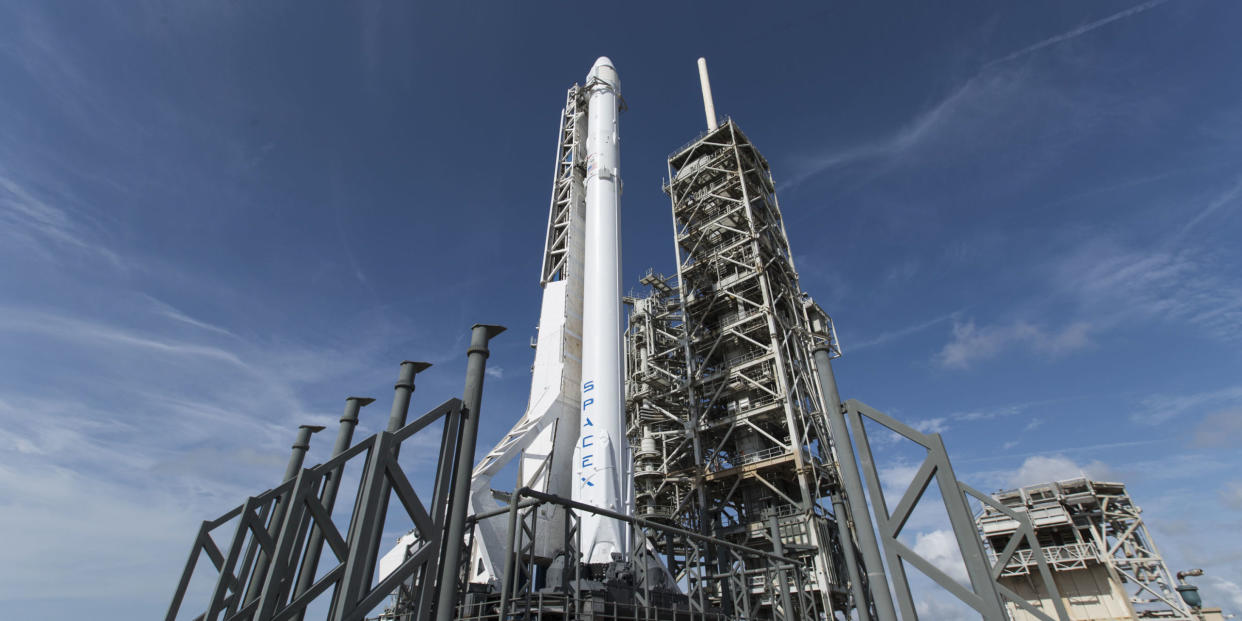SpaceX to Launch a Supercomputer and Army Satellite to the ISS This Afternoon

SpaceX is preparing to launch a Falcon 9 from Cape Canaveral this afternoon to send a Dragon capsule full of cargo to the International Space Station. The mission, CRS-12, will be SpaceX's twelfth resupply mission to the ISS and its eleventh Falcon 9 launch this year. Liftoff is scheduled for 12:31 p.m. EDT with a 70 percent chance of favorable weather conditions. SpaceX will attempt to land the rocket's first stage at Landing Zone 1 at the Cape.
The launch will carry about 3 tons of supplies to the ISS, including a supercomputer built by Hewlett Packard, a U.S. Army imaging satellite, and multiple science experiments. The Spaceborne Computer is part of a year-long HP and NASA experiment to run a high-speed commercial computer in space, which has never been done before. The computer is designed to improve NASA's data processing capabilities in space and mitigate the challenges presented by communication latencies, which could be as long as 20 minutes each way during a future mission to Mars. By running the computer for an entire year in the harsh conditions of space, HP and NASA hope to simulate the conditions of a crewed mission to Mars and develop the computing capabilities that will make it possible to land astronauts on the Red Planet.
The Dragon cargo spacecraft will also carry a U.S. Army satellite known as the Kestrel Eye. The small optical satellite, built by Adcole Maryland Aerospace, is designed to test the viability of using microsatellites to supply critical information to combat commanders on the ground in near real time. The Kestrel Eye should be able to provide satellite imagery to warfighters without relaying the data through the United States, and Lt. Gen. James Dickinson told Space News that a ground station has already been constructed to support the satellite. If Kestrel Eye works as advertised, the Army could launch dozens of similar satellites to create a network of small, low-cost imaging satellites to support warfighting operations.

The SpaceX launch will also carry three major NASA science experiments to the orbiting space station. One is the Cosmic Ray Energetics and Mass (CREAM) instrument, which will measure the charge of particles traveling through space. The instrument will help astronomers track the history of cosmic rays in the galaxy and determine if these beams of supercharged particles come primarily from supernova ejections.
Another experiment bound for the space station will test the viability of growing protein crystals in microgravity, where they can grow larger and in more perfect shapes. The experiment, supported by the Michael J. Fox Foundation, will attempt to grow crystals of Leucine-rich repeat kinase 2 (LRRK2), a protein that is associated with increased risk of Parkinson's disease. Studying large LRRK2 crystals could help medical scientists develop new treatments for Parkinson's.
The other major experiment on today's launch will be used by astronauts to attempt to grow human lung tissue in space. In controlled conditions aboard the ISS, bioengineered lung tissue could be used to test new drugs and chemicals when researching treatments for various lung diseases.
SpaceX last launched a Falcon 9 on July 5. That rocket carried the Intelsat 35e communications satellite, one of the company's heaviest payloads to date. The spaceflight company paused its launch operations while the Air Force performed maintenance on the launch ranges at the Cape and along the East Coast. The hiatus means SpaceX has a busy launch manifest planned for the remainder of the year, with at least six flights scheduled to launch before November 1.
SpaceX said today's launch will be the last time a new Dragon cargo spacecraft is used, and future flights will use refurbished Dragon capsules recovered in the ocean after launch. The move to used Dragon spacecraft will allow SpaceX to focus on completing development of its Crewed Dragon, also known as Dragon 2.
The company also plans to launch the Falcon Heavy for the first time before the year is out, though Elon Musk has warned the first Falcon Heavy launch, with three first-stage boosters, has a high chance of failure. It's going to be a busy end of the year for the Space Exploration Technologies Corporation.
You Might Also Like

